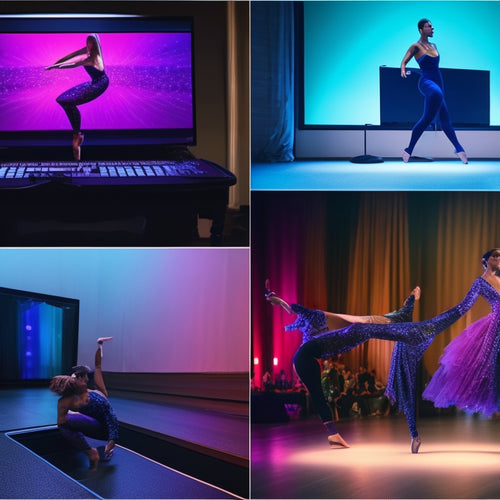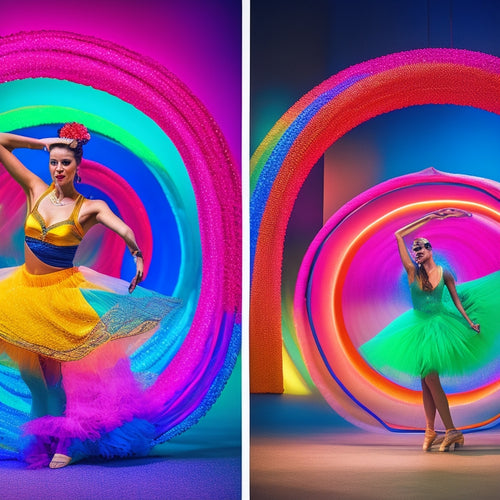
Why Do Advanced Dancers Struggle With Fluid Transitions?
Share
You've invested heavily in perfecting your dance technique, yet still struggle to achieve seamless changes between movements. So, what's holding you back? It's likely a combination of factors. You may be relying too heavily on muscle memory, neglecting mindful movement and awareness. Weak core strength, inadequate practice, and fear of mistakes can also hinder smooth shifts. Additionally, overthinking, inconsistent training, and limited musicality can disrupt your progress. By addressing these underlying issues, you'll be able to refine your technique and enable smooth, effortless changes - and there's more to explore on this journey to mastery.
Key Takeaways
• Inconsistent practice and lack of repetition hinder the development of muscle memory, leading to struggles with fluid transitions.
• Weak core strength and poor posture habits disrupt pelvic stability and control, affecting smooth shifts and fluidity.
• Fear of mistakes and self-doubt cause performance anxiety, undermining confidence and fluid movement.
• Overthinking and analysis of every step lead to mental blockades, hindering progress and fluid transitions.
• Inadequate body awareness and control make it difficult for dancers to execute fluid shifts, highlighting the need for refined proprioceptive mapping.
Muscle Memory Vs. Mindful Movement
As you work to master seamless changes, you're likely torn between relying on muscle memory and cultivating mindful movement, two approaches that often seem at odds with each other. However, it's important to understand that both are vital for achieving fluid shifts.
Muscle memory allows your body to execute complex movements with ease, but it can also lead to mindless repetition and stagnation. On the other hand, mindful movement encourages awareness and control, but it can slow you down and make you doubt your abilities.
The key is to strike a balance between the two. Neuroplasticity Training can help you rewire your brain to adapt to new movements and shifts, making it an indispensable tool for advanced dancers.
By incorporating Conscious Choreography into your practice, you can develop a deeper understanding of your body's capabilities and limitations, allowing you to make intentional choices that improve your overall performance.
Lack of Core Strength and Control
As you work to master smooth shifts, you'll likely encounter an essential obstacle: your own core strength and control.
You may not even realize that weak core muscles, poor posture habits, and inefficient breathing patterns are holding you back from achieving seamless movements.
Weak Core Muscles
Your weak core muscles, incapable of generating sufficient stabilization and control, hinder your ability to execute smooth shifts. As an advanced dancer, you may not realize that your core is the foundation of your movement. Weak core muscles fail to provide the necessary support, causing your body to compensate and resulting in stiff, jerky movements.
To improve your transitions, it's essential to focus on core engagement. This means activating your transverse abdominis muscle to maintain pelvic stability. When your pelvis is stable, you can generate power and control, allowing for seamless transitions.
To develop core strength and control, incorporate exercises that target your core muscles, such as planks, bridges, and pelvic tilts. Practice engaging your core during simple movements like walking or standing, and gradually increase the intensity as you build strength.
Poor Posture Habits
When you habitually slouch or sway, your poor posture habits undermine the core strength and control you're trying to develop, perpetuating stiff, jerky movements that make fluid shifts elusive. As an advanced dancer, you may not even realize the negative impact of your daily posture on your dancing.
Here are some common signs of poor posture habits that might be holding you back:
-
Slouchy tendencies: When you're sitting or standing, do you tend to slouch forward, putting strain on your lower back and hips?
-
Habitual misalignment: Do you often find yourself standing with your weight unevenly distributed, or with your shoulders rolled forward?
-
Do you experience frequent back or neck pain, even when you're not dancing?
- Are your movements often stilted or stiff, lacking the fluidity you aim for?
Inefficient Breathing Patterns
You compensate for inadequate core strength and control by relying on shallow chest breathing, which restricts your diaphragm's ability to fully expand and contract. This inefficient breathing pattern hinders your fluid transitions, as it limits your diaphragm's capacity to efficiently oxygenate your muscles. As a result, you may experience fatigue, tension, and reduced coordination.
Diaphragmatic limitations can lead to chest constriction, causing your rib cage to expand outwardly, rather than downwardly, restricting your lung capacity. This, in turn, affects your posture, balance, and overall movement quality. When you're not using your diaphragm efficiently, you're more prone to shallow, rapid breaths, which can disrupt your body's natural harmony.
To overcome these limitations, it's essential to develop a stronger core and improve your breathing technique. By engaging your transverse abdominis muscle, you'll stabilize your core and enhance your diaphragmatic function. This will enable you to breathe more efficiently, allowing for smoother, more fluid transitions.
Inadequate Practice and Repetition
Inadequate practice and repetition hinder advanced dancers' ability to master seamless shifts. They fail to commit complex movements to long-term muscle memory. You may have the technical skills, but without sufficient repetition, your body won't be able to execute them smoothly.
Here are some common pitfalls to avoid:
-
Insufficient drilling: You're not repeating movements enough to solidify them in your muscle memory.
-
Rushed mastery: You're trying to perfect a step before fully absorbing the previous one, leading to a weak foundation.
-
Inconsistent practice schedule: Your practice sessions are sporadic, making it difficult to build momentum and consistency.
- Lack of focus on connections: You're prioritizing perfecting individual steps over mastering the connections between them.
Fear of Mistakes and Self-Doubt
As you work to master smooth progressions, you're likely no stranger to the nagging fear of failure that can creep in and undermine your confidence.
You may catch yourself wondering if you're truly capable of executing intricate movements seamlessly, or if you're just pretending to be a skilled dancer.
This self-doubt can be paralyzing, causing you to second-guess every step and stumble over your own feet.
Fear of Failure
Advanced dancers often struggle with smooth shifts because they're crippled by the fear of failure, which manifests as an overwhelming anxiety about making mistakes that can undermine their confidence and sabotage their performance. This fear of failure can lead to performance anxiety, causing mental blocks that hinder your ability to execute fluid transformations. You may find yourself overthinking every step, worried that one misstep will ruin the entire performance.
Some common signs of fear of failure in advanced dancers include:
- Freezing up during performances, causing awkward pauses or stumbles
- Over-rehearsing to compensate for perceived inadequacies
- Avoiding certain moves or routines due to fear of not executing them perfectly
- Experiencing physical symptoms like trembling or nausea before or during performances
Doubting One's Abilities
Your inner critic can be a formidable foe, whispering doubts about your abilities and fueling fears that a single misstep will expose your supposed inadequacies to the world. This self-criticism can be overwhelming, making you question your skills and second-guess every move.
You may feel like an imposter, as if you've been pretending to be a skilled dancer when in reality, you're just winging it. This phenomenon is known as Impostor syndrome, where you doubt your accomplishments and fear being 'found out.'
When self-doubt creeps in, it's essential to recognize that it's a normal part of the learning process. Even advanced dancers experience moments of uncertainty. Instead of letting fear take the reins, acknowledge your doubts and reframe them as opportunities for growth.
Remind yourself of your past successes and the hard work you've invested in your craft. Focus on the process, not perfection. By doing so, you'll begin to quiet that inner critic and develop a more compassionate, constructive mindset. This shift in perspective will help you navigate fluid transitions with confidence and poise.
Overthinking and Analysis Paralysis
When you overanalyze every step, you risk falling prey to analysis paralysis, a mental gridlock that freezes your movement and stifles your ability to execute fluid changes. As an advanced dancer, you're prone to overthinking, which can lead to mental blockades that hinder your progress.
You start to break down each movement into tiny components, trying to perfect every detail, but ultimately, you end up stuck.
Here are some common overthinking pitfalls to watch out for:
-
Fear of imperfection: You're so focused on executing each step flawlessly that you become paralyzed by the fear of making mistakes.
-
Overreliance on technique: You're so caught up in perfecting your technique that you forget to let your body move naturally.
-
Analysis of every step: You're constantly analyzing every step, every movement, and every gesture, which leads to mental fatigue and stagnation.
- Lack of trust in your training: You second-guess your abilities, doubting whether you've practiced enough or if you're truly prepared.
Inconsistent Training and Feedback
Inconsistent training schedules and unreliable feedback from instructors or peers can disrupt your muscle memory, causing you to struggle with smooth shifts and undermining your hard-earned technical skills.
When you're working with variable coaching or unreliable mentors, it's challenging to develop a consistent approach to your dance training. You may receive conflicting advice or feedback that contradicts what you've learned previously, leading to confusion and frustration. This inconsistency can affect your ability to execute fluid changes, making it difficult to connect movements seamlessly.
As a result, you may find yourself overthinking or second-guessing your movements, which can further disrupt your muscle memory.
Establishing a consistent training schedule and working with instructors or mentors who provide reliable and constructive feedback is crucial. This will help you build trust in your abilities and develop a stronger connection between your mind and body, allowing you to execute smooth adjustments with confidence.
Limited Musicality and Timing
Dancers who struggle with smooth shifts often lack a deep understanding of musicality and timing, which hinders their ability to connect movements seamlessly. As a result, you may find yourself struggling to execute fluid transformations, even with extensive training and practice. This limitation in musicality and timing can be attributed to a lack of rhythmic intelligence, making it challenging to navigate complex rhythms and polyrhythmic complexity.
To improve your musicality and timing, focus on the following:
-
Develop your internal metronome: Practice tapping your foot or clapping along with the music to internalize the rhythm and timing.
-
Analyze the music structure: Study the composition of the music, including the melody, harmony, and rhythm, to better understand the overall musicality.
-
Experiment with polyrhythms: Practice coordinating different rhythms with your body parts, such as tapping your feet and clapping your hands, to improve your rhythmic intelligence.
- Immerse yourself in the music: Listen to the music repeatedly, allowing yourself to absorb the rhythm, melody, and harmony, and move your body in response.
Insufficient Body Awareness and Control
Your inability to connect movements seamlessly may also stem from insufficient body awareness and control, which hinders your ability to execute fluid shifts. As an advanced dancer, you may have developed muscle memory, but it's pivotal to refine your internal proprioceptive mapping to navigate shifts with ease.
This requires developing a deeper understanding of your body's spatial awareness, movement patterns, and kinetic chain connections.
To overcome this limitation, focus on neuroplasticity retraining exercises that challenge your brain-body connection. Engage in activities that promote proprioceptive awareness, such as yoga, Pilates, or somatic practices.
These exercises will help you develop a more nuanced sense of body awareness, allowing you to better control your movements and execute shifts with fluidity.
Frequently Asked Questions
How Can I Maintain Fluid Transitions When Tired or Under Pressure?
When exhausted or under pressure, you can maintain fluid changes by employing mental tricks like visualization and positive self-talk, while also utilizing breathing techniques like diaphragmatic breathing to calm your nerves and focus.
Are There Specific Exercises for Building Core Strength for Dance?
As you perfect your pirouettes, remember that a strong core is like a steady anchor, providing stability amidst whirlwind movements. Focus on exercises that engage your core, such as planks and pelvic tilts, to build the Pelvic Stability and Core Engagements essential for fluid transformations.
Can Fluid Transitions Be Achieved Through Solo Practice or Only With a Partner?
You can achieve smooth shifts through solo practice, focusing on independent mastery of technique, but partner chemistry is vital for seamless execution, so it's important to balance solo work with partner practice for best results.
How Do I Balance Practice and Rest to Avoid Burnout and Injury?
As you navigate the delicate dance between practice and rest, you must prioritize mindful scheduling, allowing for prioritized relaxation and energy management, setting healthy boundaries to avoid burnout, and incorporating active recovery to safeguard your well-being.
Can Fluid Transitions Be Taught or Are They an Innate Ability?
As you explore fluid shifts, remember that they can be taught, but natural talent and innate rhythm play a role. Your learning style and muscle memory development will also impact your ability to master smooth shifts.
Related Posts
-

Elevate Your Dance Choreography With Top Video Editing Tools
You're just a few clicks away from maximizing your dance choreography potential! With top video editing tools like Ad...
-

Dance Props to Take Choreography to the Next Level
Dance props are your secret weapons for altering choreography into a breathtaking masterpiece. They breathe life into...
-

Groove in Your Kitchen With Digital Download
With a digital download, you can instantly transform your kitchen into a vibrant space that reflects your personal st...


